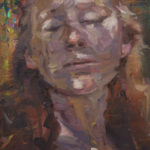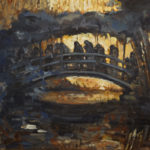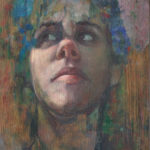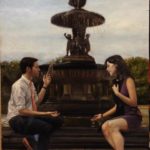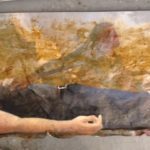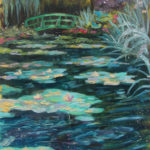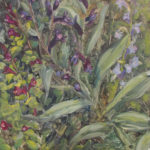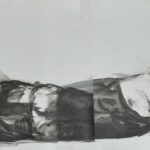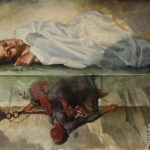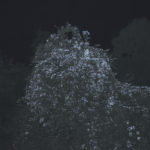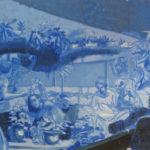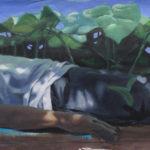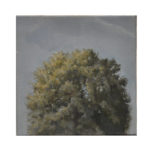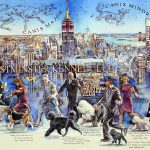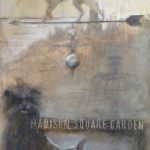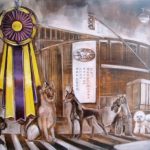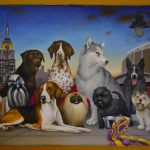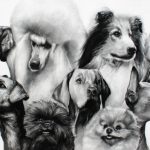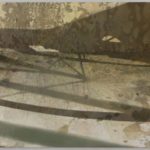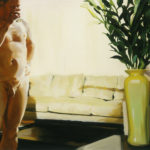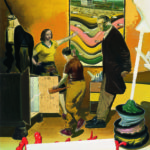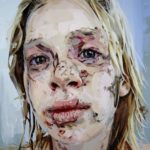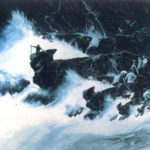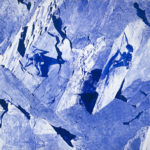THE TA LIFE
I knew I wanted to be a teacher the first time I walked out of critiques in my Painting I class in undergrad. Fairly shattered by the less than stellar feedback, I remember asking my painting teacher, “Am I just not cut out for this?”
During my time at the Academy, I was determined to gain teaching experience. I started out as a Teaching Assistant (TA) for Continuing Education (CE) classes assisting in beginner courses. At the beginner level, I was able to offer practical demonstrations, give feedback on the CE student’s work while observing the instructor’s teaching techniques. After graduation, I decided to continue to pursue teaching and gain more experience by becoming a Teaching Assistant in the MFA Program. I signed up for a variety of courses ranging from studio to seminar classes, expanding my repertoire of subjects I would become qualified to teach.

I wanted to go above and beyond what was expected of me. I set out to build relationships with students and extend my participation outside of class. I set up one-on-one meetings, edited research and thesis paper drafts and gave personal studio critiques. For each course, I committed an additional four hours a week to further interact with students and create resources for their benefit. One of these projects included the creation of an online image data base: ART and CULTURE: Images (Art and Culture I: IMAGES and Art and Culture II: IMAGES). To help expand students’ knowledge of artists, both historical and contemporary, I compiled every artist’s name mentioned during each class and uploaded images. This database is an art historical resource that also helps students discover new artists to reference in their studio practice.
As a side project to a class I am currently TA-ing, I am developing an online community that would act as a resource and forum for information regarding studio/group critiques (http://critique-critic.tumblr.com/). CRITIQUE-CRITIC (CC) will be a resource for information about different approaches to art criticism while examining institutional art critiques. This website will not only be a compilation of different perspectives but a place to post student work—in progress or otherwise—to get feedback from other students in programs nationwide. As a direct outcome of this project, I hope to create a platform that showcases emerging artists and writers.
 To date, my work as a TA has allowed me to work with several amazing artists including John Cichowski, Bonnie DeWitt, Catherine Howe, John Jacobsmeyer, and Jean-Pierre Roy. Being a Teaching Assistant has not only helped me improve my ability to demonstrate and communicate the knowledge I acquired at the Academy, but also to create connections with current students, faculty, and alumni outside of the classroom. It has allowed me to pursue my goal of becoming a teacher while also allowing me to give back to the Academy community post graduation.
To date, my work as a TA has allowed me to work with several amazing artists including John Cichowski, Bonnie DeWitt, Catherine Howe, John Jacobsmeyer, and Jean-Pierre Roy. Being a Teaching Assistant has not only helped me improve my ability to demonstrate and communicate the knowledge I acquired at the Academy, but also to create connections with current students, faculty, and alumni outside of the classroom. It has allowed me to pursue my goal of becoming a teacher while also allowing me to give back to the Academy community post graduation. ##
Interested in becoming a TA at the Academy? Please contact Katie Hemmer in the Academic Office khemmer@nyaa.edu.
To learn more about Megan Ewert visit her website www.megan-ewert.com
Franklyn Project – The First Generation
How did the Franklyn Project begin? Evolve?
The genesis of the Franklyn Project began toward the end of our first year at the New York Academy of Art and into the summer of 2013. We were so overwhelmed with all the information we had gained that we really needed a way to unwind, let it sink in, and not think too much. It started with a few people in the basement just wanting to have fun with painting again, with no stress. We have a shared respect for each other’s work so we decided to paint a painting in 30 minutes on the same panel at the same time. Every ten minutes we would switch spots and finish each other’s areas. People started to crowd around to see the process unfold.
Next, we did portraits of each other on separate canvases, switching every 15 minutes till we decided they were done. It started to turn into a battle, pushing areas in one pass to find out the next turn it was taken in a different direction. They don’t always turn out, but we all have a shared trust. From that point, we liked some of the things we were seeing, so we decided to bring in more people. This time we had four people in one studio, four blank canvases on each wall. We rotated every 15 minutes, this was also when we introduced Warhol as our subject matter. It was a beautiful thing to see unravel.
Since the work wasn’t part of anyone’s personal body of work, it freed us up to experiment and try things that we may never have been interested in pursuing in our own work. The first project, “Portraits of Our Father”, sat somewhere between just having fun with each other, feeling out what it’s like to paint with a lot of other people on the same painting, and trying to make a more poignant artistic statement, (probably a little more of the former two). Now, however, the real possibilities of a collective have begun to manifest themselves in our collective consciousness and we’re working to streamline a vision and take on projects with a little more organization and gusto. The process is ever evolving but the intent stays true.
What sets us apart besides the fact that we all paint on the same paintings, is the variety that can come out of these shows. You put some of the best up and coming artists from all over the world with different backgrounds and styles into one room and somehow they can not only agree on pieces but thoroughly enjoy what is being produced. What is being made surprises us every time we do it.
Now that the show at BSAC is over, what’s next? Tell us what’s to come for your collective.
You can find us working in our studios. At times we get together as a group to discuss the work. We often paint together as a group. These meetings are lively and social. They always include food, drink, and music. Of course the goal is to make work, but these meetings also help us stay connected and reinforce our sense of community. The locations and times of these meetings are always changing. There is no password.
Funny you should ask, because the first rule of Franklyn Project is don’t talk about Fight Club. The Second rule is you must drink while you paint. The Third rule is have fun. Anonymity is important because it’s all about the group effort and not the individual, I know people kind of know who’s in it but it’s not shouted from the roof tops. We are all pursing our own artistic paths and we don’t want the project to define us individually.
Will there be subsequent generations? Time will tell. Right now though, the first generation is still just getting started.
In 2014, the Franklyn Project will not only ________, but will also _________.
| Franklyn Project egg – Fabergé The Big Egg Hunt (on view Spring 2014) |
##
Join us for MFA OPEN STUDIOS on Friday, April 25, 6-9pm to get to know our artists and their work better. Curious to see more Academy student work from the MFA 2014 and MFA 2015 classes before then, check out the Student Work Online Gallery.
Mid-Year Critiques
 It might be said that one of the frustrating things about mid year critiques is that as soon as they’re over, the school closes because Christmas around the corner. But what about all that advice you’ve just been given?
It might be said that one of the frustrating things about mid year critiques is that as soon as they’re over, the school closes because Christmas around the corner. But what about all that advice you’ve just been given?

Regardless of whether your own critique went well, or whether it was a disaster, it’s probably a good thing that no one really remembers in the immediate aftermath what had been said. A few salient comments stick in your mind but really, when you’re under the spot light in front of one hundred-or-so of your peers, adrenalin kicks in and part of you snaps in to survivor mode. On critique day, all the work you’ve done thus far – the desperate search for meaningful content and that entirely original stroke of genius that makes your artistic “voice” more Pavarotti than the guy at the 14th street subway who for years never quite managed to figure out the lyrics to The Beatles song he keeps singing – all that exertion is finally, and in one fell swoop of the 15 minutes you’re assigned, either deemed worthwhile or, heaven forbid, a fundamental “mismanagement” of time.

Although I had only witnessed a couple of the mid-year critiques the previous year, I had heard the horror stories. In the days leading up to critiques for my fellow class of 2014, compatriots were divided between fear of imminent apocalyptic disaster and a Joan of Arc-esque sense of martyred stoicism. You try to tell yourself it doesn’t matter that much, that you’ve done what can. By the time you you’re hanging your work, you are falling apart at the seams because you’re suddenly overcome with grief at the lackluster body of work you’ve produced. However, when my name was finally called and the formal introduction made, something unexpected happened. I found myself switching into the role of a host. As I gave my little blurb about what my work was about, it felt as though I was welcoming them into the party that I guess is my art making. And then it was all a blur.

All in all, the experience for us students was a good one. And I didn’t even feel the urge to cry. At the end, when people gave their congrats and shook my hand, and exhaled with a somewhat shaky sense of relief, thinking, ‘it’s all over…for now’. All in all the experience for us students was a good one. And I didn’t even feel the urge to cry. Especially at the end when people gave their congratulations and shook your hand, and you exhaled with a somewhat shaky sense of relief, thinking, “it’s all over…for now”.
##
“The Big Picture” According to Casey Read (MFA 2014)
In New York City, I have discovered an overwhelming wealth of information regarding sensory overload. Touching, smelling, tasting, hearing, and seeing everything, like a trip to the grocery store. Touching subway poles, smelling the car exhaust, tasting the worldly cuisines, and watching the masses pass and shove their way through to the next event of the day. But I have not experienced, in my short time here, anything like the opening of The Big Picture.
 |
| Mark Tansey, Coastline Measure 1987 |
 |
|||||
| Mark Tansey, Duet, 2004 |
On the night of the opening, I hardly looked at the art. The floor was filled with people stretching to look at the works and chat amongst themselves. A slight social anxiety crept over a few of the current students at the New York Academy of Art, me included. There are only seven pieces in The Big Picture, which made the gallery appear smaller than usual and with all the people inside the hallway, there was no way to fully experience each piece. This isn’t to say that the night was made worse, the crowd filled the air with an excitement I had never seen at the school and I felt pleased to know that each time someone passed through our doors, another face lit up with a sense of awe. After painting class yesterday, I ventured downstairs to realize the privilege of viewing the artwork one-on-one. Once I experienced the show on my own, there was no comparison to seeing it with human heads blocking the view. It sounds silly, but I felt a near spiritual involvement with the work, as though I had meditated and had a conversation with each at the same time. I had been painting from life the entire day, moving at a range of distances from my 36 inches x 42 inches canvas to gain a better understanding of how it looked from up close and far away. I especially noticed this with the work by Mark Tansey. I approached his work until I was sitting an arm’s length away and realized that the entire illusion of space and depth in his painting, Coastline Measure, were created by nothing more than scribbles. My interest increased as I got up and walked backwards from the scribbles. I felt like a child again – a smile grew on my face, “It’s like magic”! Not only did I feel childlike as a result of Tansey’s “magic trick” with mark-making, but also due to the fact that I was physically about a third of the size of his 87 inches x 122 inches piece.
 |
||||||
| Jenny Saville, Bleach, 2008 |
 |
| Eric Fischl, Krefeld Project: Living Room, Scene 1, 2002 |
 |
| Eric Fishl, Corrida In Ronda # 4, 2008 |
Eric Fischl is actually one of the reasons I came to study at the Academy- I had never heard of the school until I e-mailed him for a project interview in undergraduate school and he replied. He even told me about the Academy after he asked me to send him pictures of my work. Eric changed the way I think about painting. As a drawing concentration in undergrad, painting meant I had dabbled in abstract acrylic painting since high school and then took two classes in college. It was intimidating- it meant color and wet stuff and, basically, making a lot of terrible art. I did and still do make terrible paintings, but the difference is that researching artists, their work, and how they make it helped me make some good ones too. Fischl was one of the first painters I really looked into and I was surprised to discover that his process involved photography and even mismatching figures from separate photos and shoving them in together. Not only that, but he also based much of his early work on unnerving suburban unrest which I completely related to growing up in Southern California. Seeing his work for the first time in the flesh is something personal and special to me.
Now we get to Vincent Desiderio: Father, husband, and considered (by me) to be one of the most prolific painters in these contemporary times. Of all the paintings in The Big Picture, his is the largest, entitled Quixote. Comprised of three parts (that I initially did not come close to understanding), it tortures the viewer with a heart-shaped object (perhaps a piano) falling amongst the clouds, a silhouette of a bicycle, and a slaughtered animal (a pig, I believe). To me, it almost seems like he is trying to play a game with me like “hey, make a word out of these three images” or “what do these things have in common” or even “I have seen these images on a daily basis, have you?” I find myself struggling to make an answer for these metaphoric images, but maybe that is the point. There are obscurities in life that we, as people, were never meant to find an answer to. The novel A Hitchhiker’s Guide to the Galaxy comes to mind in which the smartest computer in the universe is asked “the ultimate question to life, the universe, and everything” and comes up with the answer “42”. Either that, or I need to do more research on this brilliant guy.
 |
| Neo Rauch Hausmeister, 2002 |
Neo Rauch is a weirdo. I mean this in the most loving way. Hausmeister appears like an old billboard from the 1950’s on homeschooling. His voyeuristic approach to the home setting offers the viewer a strange look at a family in an unbalanced situation. Plates are stacked off to the right of the scene, held together by colorful goo that is repeated in the geology poster that the woman in the painting gestures towards, her gaze down at the boy (who has his back turned to the viewer). It seems as though everything in the scene is failing; the woman appears to be teaching, but the boy is busy taking a bottle of something out of a mini fridge. Only, it might not be a refrigerator at all and an odd, deformed statue of a unicorn type creature stands atop the “refrigerator.” The man in the room looks grim, yet indifferent to the situation. Neo Rauch composes places that, at first glance, seem ordinary or even dull. But looking further, the scene can create a realm for the viewer in which there is no sense and only a dark humor to drown in. In order to enter into the world of this piece, you will have to see it for yourself.
##
The Big Picture is currently on view at the Wilkinson Gallery at the New York Academy of Art located at 111 Franklin Street between West Broadway & Church through March 2nd. Be sure to visit the exhibition during the gallery hours of 2:00-8:00pm daily except Wednesdays and holidays. Admission is free. For more information on The Big Picture please visit its exhibitions page on the Academy’s website.
Artist-in-Residence at Giverny 2014

During the summer of 2013 Jessica Benjamin (MFA 2014), Adam Cross (MFA 2014), Alonsa Guevara (MFA 2014), Shannon Kenny (MFA 2013), Daniela Kovacic Muzio (MFA 2013), William Logan (MFA 2014), Kerry Thompson (MFA 2014) and Steve Vollo (MFA 2014) participated in a two-week Artist-in-Residence Program at the Terra Foundation for American Art-Europe.
The foundation is located in the village of Giverny, France, next to Monet’s house and gardens.
The Academy’s Giverny Residency Program is made possible by the New York Academy Travel Fund, the Villore Foundation.
- Jessica Benjamin (MFA 2014)
- Jessica Benjamin (MFA 2014)
- Jessica Benjamin (MFA 2014)
- Jessica Benjamin (MFA 2014)
- Adam Cross (MFA 2014)
- Adam Cross (MFA 2014)
- Alonsa Guevara (MFA 2014)
- Alonsa Guevara (MFA 2014)
- Alonsa Guevara (MFA 2014)
- Alonsa Guevara (MFA 2014)
- Shannon Kenny (MFA 2013)
- Daniela Kovacic Muzio (MFA 2013)
- William Logan (MFA 2014)
- Kerry Thompson (MFA 2014)
- Kerry Thompson (MFA 2014)
- Steve Vollo (MFA 2014)
- Steve Vollo (MFA 2014)
2014 Westminster Kennel Club Artwork Competition
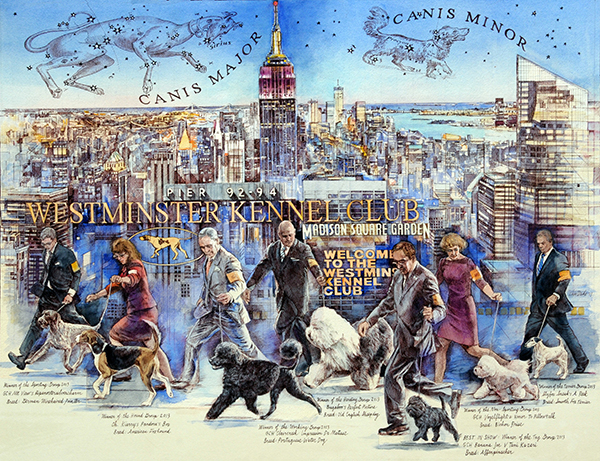
The Westminster Kennel Club Artwork Competition is a skills contest in which entrants submit artwork for use and inclusion in the promotional materials for the Westminster Kennel Club 138th Annual Dog Show. Coordinated by the New York Academy of Art and the Westminster Kennel Club the competition is open to Academy MFA students and alumni, and current continuing education students.
The 2014 Winner and Finalist works represented the Academy in our gallery booth at the 138th Annual Dog Show.
Congratulations to competition winner Chris Duke (MFA 2003), and finalists Brittany A. Fields (MFA 2013), Theresa Kasun (MFA 1992), Meredith Lachin (MFA 2011), Katherine McGough (CE), and Courtney Murphy (MFA 2008).
- Chris Duke (MFA 2003)
- Brittany A. Fields (MFA 2013)
- Theresa Kasun (MFA 1992)
- Meredith Lachin (MFA 2011)
- Katherine McGough (CE)
- Courtney Murphy (MFA 2008)
THOUGHTS BEFORE THE FIRING RANGE
 From the moment I stood to present my art pieces, I began to feel a sense of relief. Soon this public review of my work would be over, and at least now it had finally begun. All of the hard work, preparation, and anticipation for this event – the Mid-Year Critique at the New York Academy of Art – was under way.
From the moment I stood to present my art pieces, I began to feel a sense of relief. Soon this public review of my work would be over, and at least now it had finally begun. All of the hard work, preparation, and anticipation for this event – the Mid-Year Critique at the New York Academy of Art – was under way.
As silence began to fill the room, I was given the floor to introduce my work, and suddenly became fully aware of the fact that I now had the attention of the entire audience. As I let this realization sink in, I skimmed the assembly I faced. The first row of the all-star crowd staring back at me represented my critics – esteemed and admired professionals of the contemporary art world who were among my favorite living artists. Beyond that sat my colleagues, an equally talented and inspirational group of artists, possessing sharp minds and skillful hands. My fellow classmates were also capable of sophisticated critical feedback – evidenced by numerous faculty and peer discussions of each other’s works throughout the semester – but were resigned to remain silent this time, as they were not permitted comment during the Mid-Year Critiques.
The Big Picture
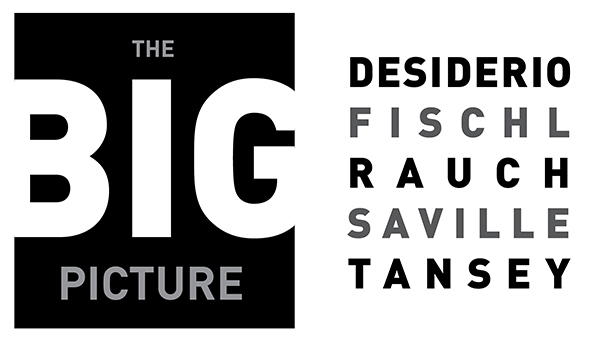
THE BIG PICTURE
Desiderio, Fischl, Rauch, Saville, Tansey
There are artists who are comfortable contributing to the art world by making their work and hoping that it finds a place in art history, and then there are the artists who make the big picture. It is these artists who seize the moment by making a statement through their work that is at once grand in scale, conceptually ambitious and specific to their era. Not satisfied waiting for their moment to arrive, big picture artists insist that what they have to say deserves an outsized scale and the world’s attention.
Desiderio, Fischl, Rauch, Saville, and Tansey are among the most compelling figurative artists working today. They work on both large and small scale paintings, but their best work and the work that we will be most likely to remember is wrought on a large scale. It is on this scale that they demand the audience’s attention and challenge contemporary art making, and on this scale that they become a part of the big picture of art history itself.
Curated by Peter Drake and organized by Elizabeth Hobson. Generous support provided by Cadogan Tate Fine Art.
For further information please contact Elizabeth Hobson: 212.842.5966 / ehobson@nyaa.edu
- Vincent Desiderio
- Eric Fischl
- Eric Fischl
- Neo Rauch
- Jenny Saville
- Mark Tansey
- Mark Tansey
The Science of Art and the Art of Science
Have you ever been faced with making a “now-or-never” decision that would forever change your life’s course? When there is a fork in the road, trusting your intuition is the bravest courses of action you can take. No one knows this better than Henry Jabbour (MFA 2015) former scientist turned painter. Last month, he sat down with us to share a bit about his decision and journey down the road less travelled.
Henry Jabbour’s life was a crossroads. Having reached an inflexion point in his research career, Henry found himself having to make a choice: a drastic decision to either continue trail blazing the path of his twenty-year career as a scientist or pursue a neophyte path as an artist.
Prior to 2011, Henry was content with his work as a scientist. He was at the top of his field as a senior scientist, program leader and honorary professor at the University of Edinburgh. With his own lab and two decades of research under his belt, Henry‘s world was all things female reproductive health, including the establishment of pregnancy on a molecular level, pre-term labor and its consequences on babies. With such a valuable research portfolio, Henry was offered the highest honor as a scientist – a Chair at the Medical School of the University of Edinburgh.
Until this point, Henry’s passion for the arts was confined to the evening classes and weekend workshops he dabbled in at the Leith School of Art. He was, however, becoming increasingly frustrated with the lack of time he had to explore his artistic vision. And his passion was becoming too loud to ignore.
Once Henry received word that he was accepted to the Academy, he knew he had made the right decision. His family and friends were also by now in full support of his passion.
During his career as a scientist, Henry had travelled extensively in the USA, attending conferences and spending sabbatical at Harvard University in Boston. Despite unfamiliarity with the city, on arriving in New York, Henry felt “completely blessed” and an immediate sense of calm once in Tribeca.
##
If you have any questions for Henry, please leave them in the comments section of the blog.
Looking at the Inside – Class of 2015 Interviews (part one)
 |
| Work by Esteban Ocampo Giraldo (MFA 2015) |
| Work by Esteban Ocampo Giraldo (MFA 2015) |
-1.jpg) |
| Work by Eric Pedersen (MFA 2015) |
 |
| Work by Eric Pedersen (MFA 2015) |
 |
| Work by Ryan Schroeder (MFA 2015) |
 |
| Work by Ryan Schroeder (MFA 2015) |
 |
| Work by Jehdy Ann Vargas (MFA 2015) |







